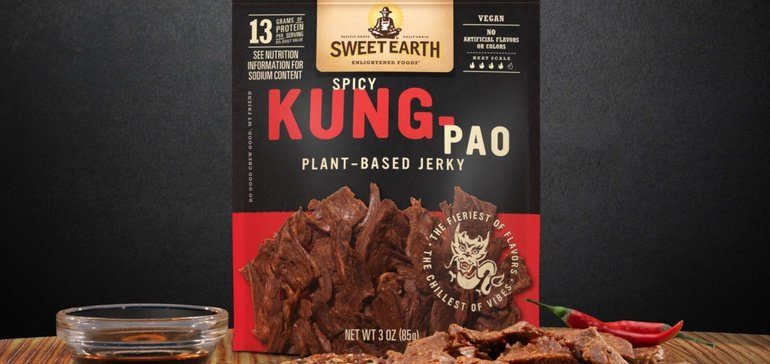Nestlé’s Sweet Earth moves into snacking aisle with plant-based jerky

Dive Brief:
- Nestlé’s Sweet Earth brand is introducing its first shelf-stable snacking product with two varieties of plant-based jerky, the company said in a statement.
- Sweet Earth’s Spicy Kung Pao Jerky will be available on shelves and online starting this month. The Sweet Korean BBQ variety will be out later in 2021. The wheat gluten-based offerings each have 13 grams of protein and no artificial flavors or coloring.
- Jerky has been a popular category that manufacturers of faux meat have been expanding into in recent years as consumers increase their consumption of plant-based foods. The demand also comes as people snack more and eat while on the go.
Dive Insight:
Sweet Earth has long made its name in the frozen section of the grocery store with its burritos, hamburgers, chicken, sausages and other offerings made from plants. But the introduction of a plant-based jerky is a big step for the Nestlé-owned brand to expand its reach to other parts of the store where it doesn’t have a presence.
“We are going beyond the bun to provide consumers a variety of flavor-forward plant-based offerings for various occasions,” said Sara Wheeler, Sweet Earth’s general manager. “Our new plant-based jerky addresses flexitarian consumers’ need for a convenient, on-the-go source of plant protein.”
The plant-based food sector has grown increasingly crowded with CPGs such as Conagra Brands, Tyson Foods, Kellogg and Hormel Foods entering the space or improving upon existing offerings to give them a taste, texture and appearance as similar as possible to meat. Nestlé’s major foray in the U.S. in plant-based food came in 2017 when it purchased Sweet Earth. Today, the brand has more than 75 plant-based products.
But for brands like Sweet Earth to command an even greater share of spending in plant-based foods, it’s imperative to have a presence throughout the store. A consumer who purchases a Sweet Earth Awesome Burger or Mindful Chik’n strips in the frozen section could immediately recognize the plant-based jerky in the snack section and choose to purchase it over a competitor’s product if they trust and enjoy the brand.
It’s a similar strategy being used by other plant-based food manufacturers. Conagra’s Gardein has its own faux chicken offerings, and the food giant has incorporated them into its other brands like Birds Eye. Even Nestlé has incorporated Sweet Earth Awesome Grounds, its plant-based ground beef option, into items that traditionally use the animal-based protein: DiGiorno Rising Crust Meatless Supreme and Stouffer’s Meatless Lasagna.
The move into a snacking offering also will give Sweet Earth more food consumption occasions. Currently, most of Sweet Earth’s foods are burritos, bowls, pizzas and burgers that typically work as a meal. Sweet Earth’s website currently only lists two options under snacks: the new jerky and a Cubano Empanada.
As consumers snack more, and increasingly travel outside their homes as the pandemic eases, having a portable, healthy offering that they can munch on could be especially valuable for Sweet Earth.
Nestlé’s challenge in growing its presence in jerky will be that some competitors are trying to do the same. Gardein has a plant-based jerky, and Krave introduced two varieties early last year. Several startups also have rolled out their own.
It’s likely the market will see even more of these plant-based jerky snacks due to the overall push away from conventional animal-sourced products. According to SPINS data commissioned by The Good Food Institute, the U.S. market for plant-based jerky hit $3.9 million for the year ending April 2019. IRI data cited by Sweet Earth showed that during the pandemic, jerky products have seen a 20% jump in demand as more people prefer to snack on protein over carbohydrates. These trends all appear to bode well for the long-term success of jerky made from plants.

